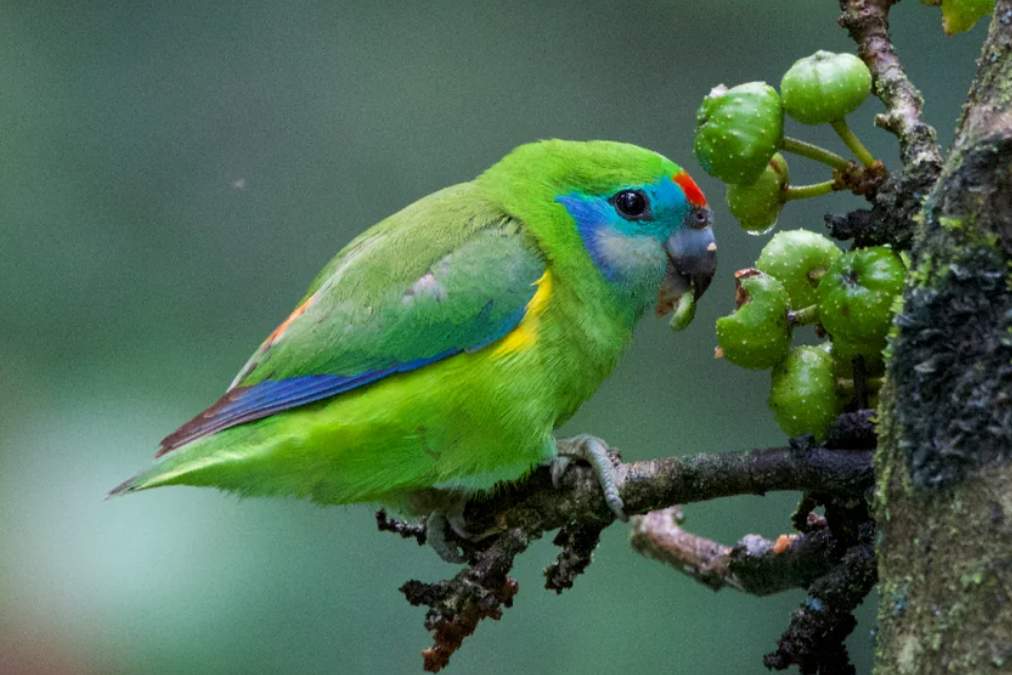DESCRIPTION
SUPERFICIALLY, THE Masked Owl (Tyto novaehollandiae) looks like a big, heavy Barn Owl. It roosts in the same places: big hollows in trees, crevices in cliffs, and even caves, but rarely heavy foliage like the Ninox owls.
It reacts in the same way if cornered, crouching, spreading its wings, swaying from side to side, and hissing, snapping and rasping. And it hunts in the same way, quartering forest country and clearings low on the wing or listening from low perches, sometimes even standing motionless on the ground.
The Masked Owl also takes similar, but larger prey: mainly small terrestrial mammals up to the size of a rabbit, varied with occasional possums and medium-sized birds such as magpies and kookaburras. If too heavy to lift, large prey is eaten on the spot, but otherwise, it is carried off in the bill or feet to a perch or the roost. Small kills are bolted whole but larger ones are usually torn into manageable strips, beginning with the head.
Rabbits have become the main prey of the very large race in Tasmania. There are similarities to Barn Owls’ end. Masked Owls often keep to heavier forested eucalypt countries, never more than 300 kilometers inland from the coast. They also seem to mate permanently and hold to the same territory all year round.
When rising each evening, males and females join each other from separate roosts, purring, chattering, and chuckling in greeting in the way that Sooty Owls do. The great difference in size between them, particularly the feet, may help them take prey of different sizes.
The approach of breeding is signaled by much twittering from both birds around the nest hollow, led by the male; before mating, they go through elaborate head-bobbing and wing waving. When they enter the nest hollow they slide down tail-first a rare characteristic of the whole masked Owl group, Barn and Sooty Owls included.

OTHER NAMES
Cave Owl, Chestnut-faced Owl. Australian Masked Owl, and Mouse Owl
LENGTH
The male length is about 350-400 mm, with much smaller talons; however, the female is 400-500 mm; over 550 mm in Tasmania. Both sexes’ wingspan is around 106 to 110 cm.
IDENTIFICATION
ADULTS: Sexes similar; male paler. Upperparts light dusky washed ochreish and finely speckled with white to gray-white boldly flecked with dusky gray. Flight feathers dull-barred dusky gray, the second and third outermost longest. The tail feathers are with six to seven dark gray bars and mottlings.
Facial disc tawny to white, with a patch of dark chestnut around the front of eyes; complete chestnut and black border ring to facial disc. The underparts tawny-ochre is with extensive dusky spots and chevrons or white with sparse dusky gray spots. The feathers on the lower parts of the feet are dense and furry, but sparse only in far northern Australia. Three basic phases in plumage:
(1) The dark tawny, with shadowy back toned tawny and dimly spotted white, rich ochreish face and ventral surface;
(2) Intermediate, with dusky back, toned pale tawny and coarsely spotted white, whitish face and ventral surface;
(3) White, with gray-white back coarsely speckled gray-and-white, white face and ventral surface, and eyes are dusky. Bill bone-white; cere flesh-white. Toes pale to mid-gray-brown; claws darker.

IMMATURE: They are similar to adults.
DOWNY YOUNG: First short white downed; later long, cream-downed.
VOICE/SOUND/CALL
Masked Owl call is a drawn-out, rasping screech similar to the call of a Barn Owl, often in flight; also chattering, ticking, and rattling.
BREEDS/NESTING
The Masked Owl is breeding erratically at any time. Nest a 40-500 cm deep, vertical hollow in tall eucalypt, or ledges in caves, prepared by males and used in successive years. Eggs: usually two-three, laid on alternate nights; off-white; ellipsoidal, 43-50 x 35-38 mm. Incubation is about 35 days, by the female; she is fed in the nest by the male each night. Young, brooded by the female for the first two-three weeks and then fed by both adults, fledge in I 0-12 weeks.
DISTRIBUTION
All coastal and sub-coastal of Australia except 80 miles of Beach and Kangaroo Island in the eucalypt forests and denser woodlands. There are five races: one large and dark-phased, with some males medium-phased in Tasmania and Bass Strait islands. One medium-sized is dark and paler-phased in females, and about equally intermediate and white-phased in males throughout southern Australia north to the Pilbara and foot of Cape York Peninsula.
One medium-sized is with sparsely feathered feet and only intermediate and white-phased in the Kimberleys and Arnhem Land east to the Gulf of Carpentaria. Furthermore, one like Kimberley-Arnhem Landrace but smaller on the Cape York Peninsula; one small but in dark- and intermediate phases on Melville Island.
Ecology
In N Australia, the bird has been recorded from riverside forests, timbered waterways, open forests, rainforest, paperbark Melaleuca swamps, and the edge of mangroves, as well as along the margins of sugar cane fields. This Owl habitually made nests in tree hollows, within patches of closed forest, and fed in open woodland on small to medium-sized terrestrial mammals. The bird normally lays 2-3 eggs.
STATUS
The Masked Owl is mysteriously scarce over most of its vast range. However, there appear to have been localized declines where it was once common. However, it is suggested that the overall density could have declined by over 50% (Near Threatened). The reason for the low density of Masked Owls in northern Australia is a mystery. It is possible the subspecies have been affected by declines in potential natural prey, such as possums, rats, and bandicoot.







